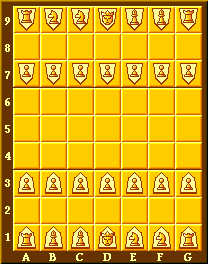Yari Shogi
Yari Shogi is a shogi variant, invented by Christian Freeling from the Netherlands in 1981. `Yari' means `lance'.
The description below is taken from the website of Christian Freeling and Ed van Zon (with permission) (slightly edited by me); and also the pictures were taken from this website, called Mindsports.
See the Mindsports website for more information on Christian Freeling's other chess variants, methods to play several of these on the Internet against others, and more.
General remark
Yari Shogi is an attempt to carry some of the characteristics of the Japanese game of Shogi to extremes, while at the same time putting the rules and the choice of pieces into a logical framework. It is assumed that the reader is familiar with the rules of Shogi.
Rules
The game is played on a board with nine rows of seven columns. The diagram below shows the board and the initial position of the pieces. All pieces are of the same colour. Sides are only distinguished by their direction. On the reverse side of each piece its promoted version is depicted.
 White:
White:
General d1; Forward Rook a1, g1; Bishop b1, c1; Knight e1, f1; Pawn a3,
b3, c3, d3, e3, f3, g3.
Black:
General d9; Forward Rook a9, g9; Bishop e9, f9; Knight b9, c9; Pawn a7,
b7, c7, d7, e7, f7, g7.
The General moves like the King in Chess.
The forward Rook covers the rank and the forward file it occupies, as indicated, i.e., it may move as a `usual' rook, but not backwards.

The Bishop covers the two squares diagonally forward and the forward file it occupies, as indicated, i.e., it may either move like a rook but only forwards, or one square diagonally forwards.
The Knight covers the forward file it occupies and the two squares that are a knight's move away and adjacent to that file, as indicated. As in Shogi (or in orthodox chess), the knight's move is a jump to the target-square, unaffected by intervening pieces. In other words, a knight can move like a rook but only forwards, or jump like a knight, but only to the position reached by going two squares horizontally forwards and one square vertically.

Pawns move one square forward and capture likewise.
From these pieces it may be clear which characteristic of Shogi has been taken to extremes here: It is Shogi's forward orientation. Except for pawn and General, all unpromoted pieces include Shogi's Lance as part of their options for movement, and with exception of the General, no unpromoted piece can move backward.
Another characteristic of Shogi is the game's ample opportunity for promoting pieces. This characteristic too has been taken to an extreme: with the implicit exception of the General, all pieces in Yari Shogi can be promoted.
A piece in Yari Shogi may promote if it ends its (non-drop) move inside the promotion-zone. As in Shogi, the promotion-zone consists of the 3 farthest ranks from the player's point of view. Promotion is optional unless not doing so would leave the piece immobile. Thus a Bishop, Knight or pawn must be promoted if moved to the ninth rank.
A forward Rook promotes to a full Rook, which is identical to the Rook in Chess.
The Bishop and the Knight both promote to Gold. This piece is similar to Shogi's Gold in that it covers the three squares in front and the two squares to the left and right. But Yari Shogi's Gold is much stronger in that it covers the whole backward file it occupies, as indicated. In other words, a Gold may move one square horizontally, one square straight forward, one square diagonally forward, or like a rook in backwards direction.
Pawns promote to Silver. This piece, again, is similar to Shogi's Silver in that it covers the three squares in front. But instead of the 2 squares diagonally backward, Yari Shogi's Silver covers the whole backward file, as indicated. Thus Silver too is much stronger than its counterpart in Shogi. In other words, a Silver may move one square straight forward, one square diagonally forward, or like a rook in backwards direction.

Note that all promoted pieces feature the 'backward Lance' as part of their options.
Drops
As in Shogi, captured pieces change sides, that is, a captured piece becomes the property of its captor. The piece is now 'in hand' and may be dropped conditionally onto a vacant square, at the cost of a turn. The conditions are:
- A piece must be dropped unpromoted.
- A drop may not render the piece immobile. Thus a bishop, knight or pawn may not be dropped on the back rank.
- A pawn may not be dropped on a file that already holds an unpromoted pawn of the same player. Thus 'double pawns', as known in Chess, are not possible in Yari Shogi.
- In Yari Shogi pawns may, like any piece, drop mate. This is the only difference with Shogi pawns.
Comment
It is planned to `feature Yari Shogi in the `Arena' of Mindsports, which means that then it is possible to play this game against others on the Internet using the well-crafted interface that is used on the Mindsports website to play several other games.
Rules written by Christian Freeling for the Mindsports Website, slightly edited for the Chess Variant Pages, and first part of introduction added by Hans Bodlaender. Rules and images copyright Mindsports; used here with permission.
WWW page made: December 16, 1997. Last modified: January 23, 2005.
